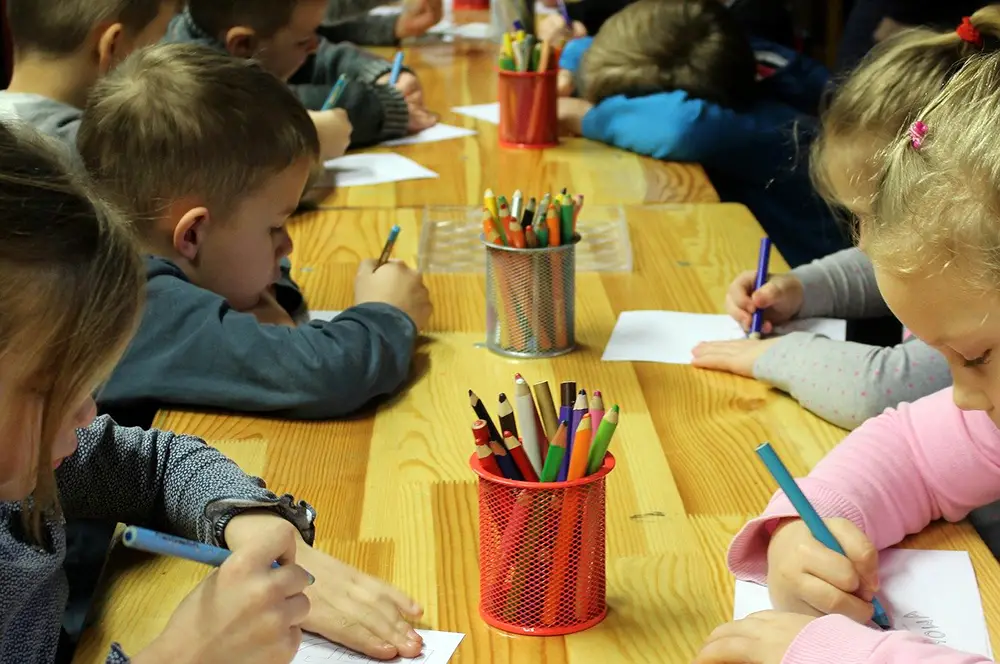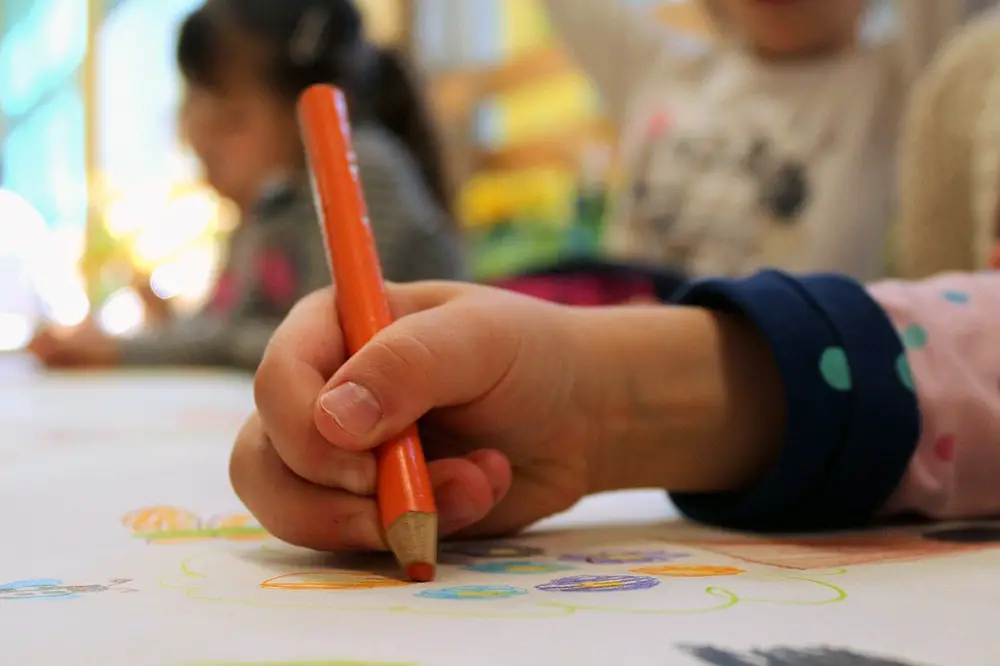When assessing which toys and games are right for your child, it can sometimes be hard to match both parents’ expectations and children’s desires. Although children will always lean towards doing what they prefer, it is possible to gently nudge them towards more beneficial pass times. Luckily, coloring pages are both favorite with young children and are also massively beneficial from a developmental point of view.
Subscribe to receive by email our FREE weekly coloring pages. Our in-house artist creates original train-themed works for your child or student to color in!
In this article we will look at the top 10 educational benefits of coloring pages:
Image by _Alicja_ from Pixabay
#1 Fine-Motor Skills
Fine-motor skills are the use of the smaller muscles in one’s hand when performing more precise tasks. Children of a very young age are notoriously lacking in these motor skills, understandably. It takes time to develop these skills but coloring is a great way of speeding things up and making fine-muscle memories more active. I am sure you have noticed that children, especially the youngest ones, are bad at coloring in the lines. This is not just because they often lack patience, it is also because they have not yet refined these fine-motor skills. Over time, their motor skills will improve if they are provided with the right activities and coloring pages are a great way to improve their ability to color within the lines.
#2 Teach Patience
As hinted above, children do have a short attention span and lack the patience (and sometimes the motivation) to see a task to completion. Coloring in, properly, takes time and patience and this is something children often struggle to learn on their own. It is much easier to teach a teenager patience, but children don’t respond the same to prompts such as: “Being patient is a valuable skill for you to have, so let’s practice that today.” On the contrary, you’ll have to approach the teaching of patience not through lecturing but through masked activities that are inducive to the skill you want to instill in your child. Coloring pages do this trick, as they are seen as a fun activity by most children but also have the benefit of making the child practice patience. Bottom line, it can improve both the behavior and your child’s self-esteem.
#3 Create Artistic Flair
Coloring is a good way of nurturing your child’s artistic flair. As a general rule, coloring pages require children to follow the outlines on the page, but not always. Sometimes you might want to encourage your child to “re-do” the scene on a blank sheet of paper, and can thus expand on more than just what the lines have set out for them to draw. Allowing your child to have the freedom to develop and expand their imagination on paper can help them express who they are. But more often than not, children need guidance before they set on a new journey, and coloring pages can be the beginning of a future love for art.
#4 Spark Creativity
Coloring allows the imagination to flow. Allowing children to show their artistic flair on a blank canvas not only creates artistic flair but can also act as a catalyst for their creative mind. Through creativity, children can express what they are thinking and feeling accurately and clearly. But they don’t just get creative over night. They need exposure to educational tools that will help their brans create new neural connections. And one of these creative tools are simple coloring pages. Creativity has real-world applications too. Being able to think outside the box and being able to approach a topic from a different point of view can help with schoolwork. The creativity sparked through art can, in the future, crossover to other subjects easily.
Image by _Alicja_ from Pixabay
#5 Improve Handwriting
Getting used to holding and using pencils, pens, crayons (or whatever writing tool your young child has access to) can be a big stepping off point. Learning to hold and use these tools accurately via the act of coloring is a completely transferable skill for when it comes to learning to write. Even in today’s highly technologized world, the benefits of good handwriting will follow your child through the entirety of their school, college and adult life.
#6 Builds on Existing Knowledge
Learning at school and home, in general, is done by building on the knowledge the child already possess. It is easier to expand on an already existing idea than have a completely new one explained to you. It’s very likely that your child will be able to recognize most of the elements on a coloring page, but as you chose more and more complex situations, there will be a lot of room for building up on already known concepts. For example, rain and snow are in your child’s basic vocabulary, but what about “sleet” and “hail”? It would be so easy to guide your child’s learning through the use of a coloring page: “Today, instead of rain, we have hail falling from the sky!” Coloring in gives a base knowledge for a lot of things and expands on previous ones. Color matching, accuracy of tracing, vocabulary, the importance of thinking ahead, are all built on and put into practice here.
#7 Pattern Recognition
Learning to identify and act on, or even create, a pattern is an important step in the psychological development of children. Coloring in is a good platform for allowing children to identify the pattern on their drawings both artistically and logically. Identifying what colors have been used, what colors will probably need to be used and where are just a few examples. Pattern recognition is the key to being able to make predictions, not grand ones, simple predictions such as: “The first rabbit I colored in was brown, so the next one will also be brown.” Or maybe, they chose to be creative and it will be rainbow colored! That ability to identify patterns and use them to help understand their environment is a great benefit of coloring pages.
#8 Allows for Self-Expression
Coloring in does not have to be done following rigid guidelines. Being able to make drawings of own can be a good way of allowing your child safe self-expression. By expressing how they feel through the choice of colors, attention to detail, and even final product display can help children better understand their own emotions. That’s why coloring therapy is such a big thing in child education. This form of expression can also save you from their temper tantrums, because a child who is given the opportunity to express their frustration on paper is better than one that expresses it through screaming, crying, or refusing to eat.
#9 Entertaining Factor
It is not all about learning. Sometimes playtime is just meant to be fun. Children like to color in, they enjoy doing it. Remember the horror stories you heard from your neighbor of that child who painted the entire living room wall in crayons? It really is as simple as that. You will see that a happy child who is allowed (and encouraged) to draw, to relax, and have fun will be calmer and more likely to behave properly when you want and/or need them to. Children need time to wind down too. Their day may not be as stressful as yours, but they still need to be engaged in relaxing activities, and coloring pages are one option.
#10 Quiet Time Alone:
Sometimes kids get angry, they get frustrated and they need time and space to cool off. Giving them some quiet time alone to cool off can be a great way to bring them back down to a more approachable attitude. Quiet time alone can also be great for self-reflection and thinking about their day, how they are feeling right now, and even relive some fun parts of their day in their imagination.
It can be hard for children to express how they feel, especially because they just don’t know how or why they are feeling a certain way. You can tell a child they are only grumpy because they are tired, but they probably won’t believe you or care about what you say unless they come to that conclusion themself. And it is also ridiculous of parents to think that children can achieve all that by simply sitting quietly in their room. Give them something to do, like a coloring page to color in, and ask them to reflect on anything that made that day memorable or problematic.
There are so many benefits for kids stemming from being engaged in the activity of coloring in. It may seem a simple game or pass time to them, but it has so many real-world benefits to everything from their hand-eye coordination to self-reflection, from prompting creative thinking to the enhancement of school-related skills. As parents, you have a duty to make sure your child is allowed time and given the resources to interact with a coloring page at least one time a week.
Now that you know these benefits, subscribe to receive by email our FREE weekly coloring pages. Our in-house artist creates original train-themed works for your child or student to color in!







